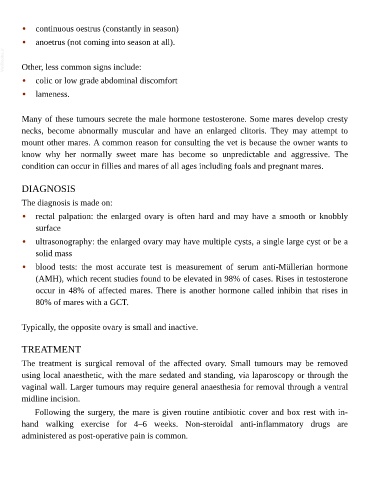Page 1030 - The Veterinary Care of the Horse
P. 1030
• continuous oestrus (constantly in season)
• anoetrus (not coming into season at all).
VetBooks.ir Other, less common signs include:
• colic or low grade abdominal discomfort
• lameness.
Many of these tumours secrete the male hormone testosterone. Some mares develop cresty
necks, become abnormally muscular and have an enlarged clitoris. They may attempt to
mount other mares. A common reason for consulting the vet is because the owner wants to
know why her normally sweet mare has become so unpredictable and aggressive. The
condition can occur in fillies and mares of all ages including foals and pregnant mares.
DIAGNOSIS
The diagnosis is made on:
• rectal palpation: the enlarged ovary is often hard and may have a smooth or knobbly
surface
• ultrasonography: the enlarged ovary may have multiple cysts, a single large cyst or be a
solid mass
• blood tests: the most accurate test is measurement of serum anti-Müllerian hormone
(AMH), which recent studies found to be elevated in 98% of cases. Rises in testosterone
occur in 48% of affected mares. There is another hormone called inhibin that rises in
80% of mares with a GCT.
Typically, the opposite ovary is small and inactive.
TREATMENT
The treatment is surgical removal of the affected ovary. Small tumours may be removed
using local anaesthetic, with the mare sedated and standing, via laparoscopy or through the
vaginal wall. Larger tumours may require general anaesthesia for removal through a ventral
midline incision.
Following the surgery, the mare is given routine antibiotic cover and box rest with in-
hand walking exercise for 4–6 weeks. Non-steroidal anti-inflammatory drugs are
administered as post-operative pain is common.

